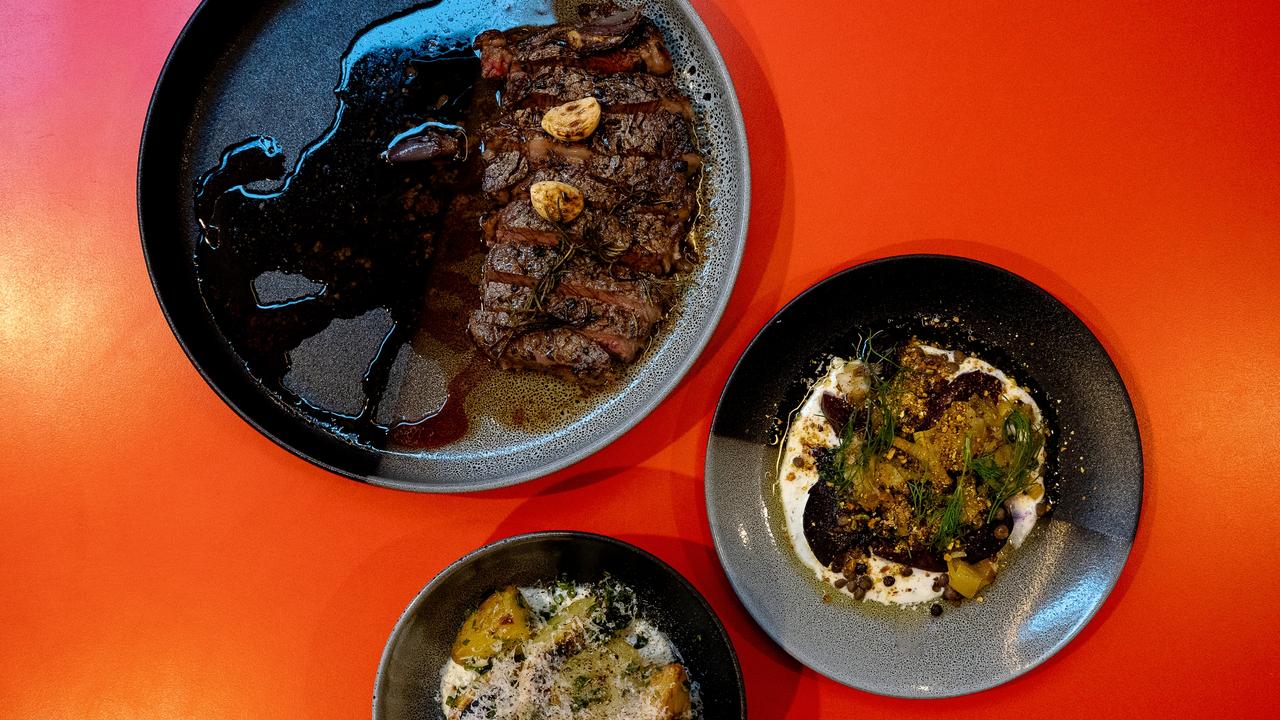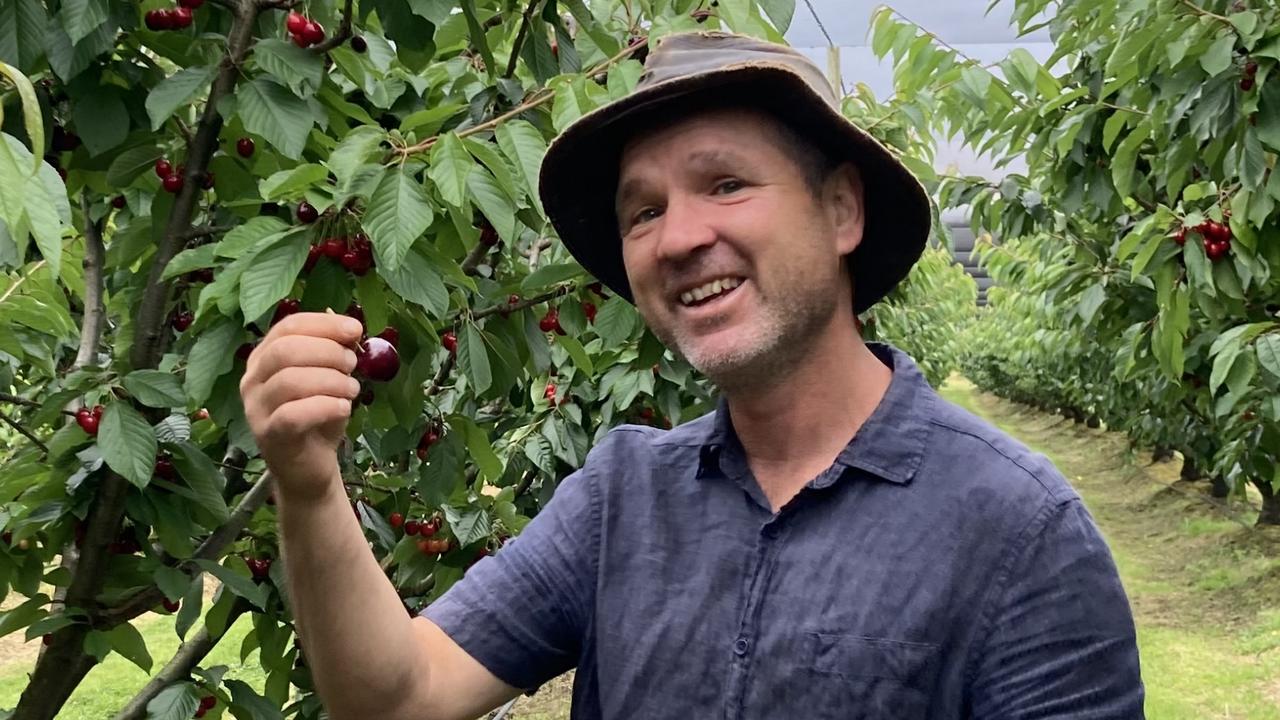TasWeekend: Dream teams in Tassie eateries
FOR many of Tassie’s top chefs, where their food comes from is just as important as how it ends up on their plates.
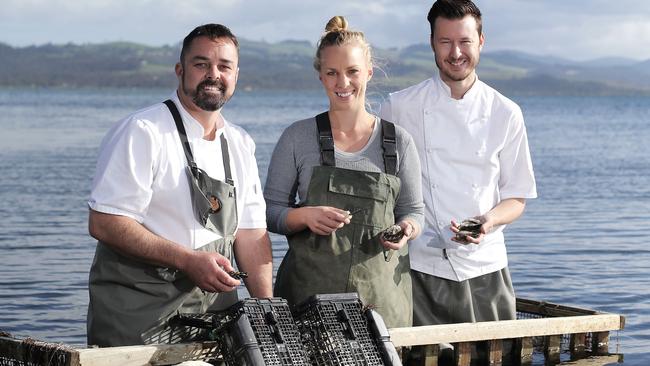
Food and Wine
Don't miss out on the headlines from Food and Wine. Followed categories will be added to My News.
IT does not take long for Christian Ryan to realise there is a hole in his waders. And the water at the Blackman Bay Oyster Farm lease near Dunalley is chilly on this Saturday morning. Luckily, Ryan and fellow chef Glenn Byrnes are basking in the glow of a gushing review in The Australian newspaper. The review, read by Ryan and Byrnes on their way down from Hobart, has nothing but praise for Aloft, which opened on the top floor of Hobart’s Brooke Street Pier last year.
Ryan and Byrnes have the talent and confidence to take their own route in terms of food combinations and preparation. They worked together at Melbourne’s Taxi Dining Room, where Byrnes was head chef before moving to Hobart to work at Garagistes. Ryan is known for Property of: Pilgrim, where he impressed with an inventive lunchtime menu. He also worked at Mona’s fine-dining restaurant The Source.
They are being good sports for the TasWeekend photo shoot, getting up early to get in the water with their oyster suppliers, Isabelle Clarkson and Rob Rodway, before preparations start for the evening’s dinner service. Despite Ryan’s water-filled waders, which make for a soggy ride home, he and Byrnes say it is a good chance to see first-hand where and how the oysters they serve at Aloft are grown.
“So much work goes into it,” Ryan says. “They’re out there producing for just a couple of businesses, which means every oyster is hand-reared and they’re out there moving the oysters, making sure every one is as good as it can be.”
Clarkson and Rodway, who are life and business partners, run a company called Ocean Delicacies Tasmania with third partner Martin Kavanagh, supplying wild “giant” Pacific oysters, periwinkles and sea urchin to the Asian market. In 2014, they bought the Blackman Bay oyster lease, focusing on low-volume, high-quality oysters for a small number of clients, including Aloft and Franklin.
During the final stage of growth the oysters are put high up on racks, which allows them to develop a hard shell and large sweet abductor muscle [the part that clings onto a rock or farm bed].
“We really strive to grow an A-grade oyster that has an amazing meat-to-shell ratio,” Clarkson says. “The meat comes right up to the rim of the shell, which we find is great to present to people. The oyster’s abductor muscle with our oysters is nice and meaty, and quite sweet and a similar texture to scallop.”
Ryan says it can be difficult for restaurateurs to gain access to Tasmania’s small growers, because demand for their produce often far outstrips their ability to supply. With the Pacific Oyster Mortality Syndrome making oysters hard to come by since the virus was detected in January, it’s been a case of “who you know” that’s allowed Aloft to access Blackman Bay oysters, which are unaffected.
Having worked in hospitality for the best part of a decade, Clarkson knew the Aloft team from her time at The Source. Now, when she is not helping Rodway at the oyster farm, Clarkson works front-of-house at Aloft. At a recent readers’ dinner for delicious magazine, Clarkson was not only waiting tables, but also acting as an unofficial brand ambassador for Blackman Bay oysters. Ryan and Byrnes created a new dish for the readers’ dinner that highlighted the many ways the delicacy can be used.
“We dehydrated oysters to make a dashi [Japanese broth] using their secondary oysters, then we smoked some oysters and turned them into a cream, then had just the beautiful oysters on top,” Byrnes says. “Normally there’s someone in the room who won’t do oysters but everyone jumped straight in.”
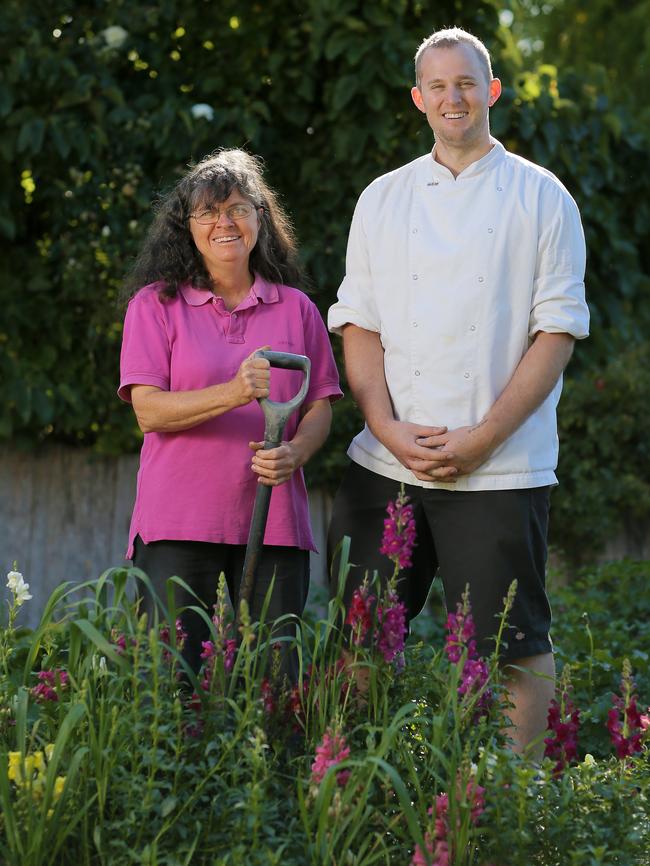
With so much Tasmanian seafood having to go through the Melbourne and Sydney fish markets before making its way back to local fishmongers and restaurants, Ryan and Bynes are keen to keep oysters on the menu as an example of seafood that can be sourced directly from producers. They believe it is “only a matter of time” before Hobart achieves a critical mass that would make a local fish market viable. “It’s just going to take the right person to figure out the logistics of getting everybody on board,” Byrnes says.
Clarkson says restaurants such as Aloft and Franklin are opening people’s eyes to the diversity of seafood products available in Tasmania, which she hopes will open up more opportunities to sell directly to customers.
“There’s a lot to be said for these particular restaurants because they’re supporting those intricate niche markets,” Clarkson says.
“These guys have really opened up that opportunity to display some of the amazing produce we have down here.”
GARDEN GOODNESS
It was with some trepidation Liz Lelong fronted up to Hobart’s Ethos restaurant three years ago to see if the team of young chefs might like to buy some of her vegetables. “They’re just vegetables,” she thought.
But a friend who had eaten at Ethos had a hunch that Lelong’s backyard bounty was just the stuff chef and owner Iain Todd would like to feature in his multi-course dinner menu. The reception Lelong received when she arrived at Ethos with her canvas grocery cart full of vegies left her “floating”, she says. “I was very nervous but I called Ethos and the person who answered the phone said, ‘Come in, the boys will love them’,” Lelong says.
“So I went in and they were really lovely. Now when I go in each week, they all seem to know my name and I feel like I’m part of something. I think Iain is so clever and sometimes he looks really tired but he always smiles and is really welcoming. I look forward to going.”
The fruit and vegetables in Lelong’s sprawling West Hobart garden, known locally as Eve’s Garden, are like something out of an Enid Blyton book. Tiny Mexican mouse melons hang from the rafters of a rickety glasshouse and, outside, rows of tomatillo bushes are covered in fanciful paper-like green balloons. At the back of the block, which is about a third of a hectare, some neglected Lazy Housewife beans hang yellow and gnarly from the vines. In prime position closest to the house are rows of high-trellised tomato vines – 20 different varieties in total. Espaliered pear trees droop with the burden of their near-ripe fruit and various lettuce and spinach-like plants sit alongside colourful stems of snapdragons.
In this edible wonderland, Todd wanders around like a kid in a lolly shop, enthusing about Lelong’s gardening skills. “It’s such an impressive use of space,” he says. “When I first came up here I was blown away by what you can get out of such a small space, through intelligence and talent.”
Todd spots a patch of something that looks like purple-tinged clover, which he identifies as oca, or as Wikipedia later informs me, oxalis tuberosa. “It’s a mouse-shaped root vegetable but you can use the leaves as well,” he says. “We’ll pick a bit off and put it on something that needs a lemony sour flavour.”
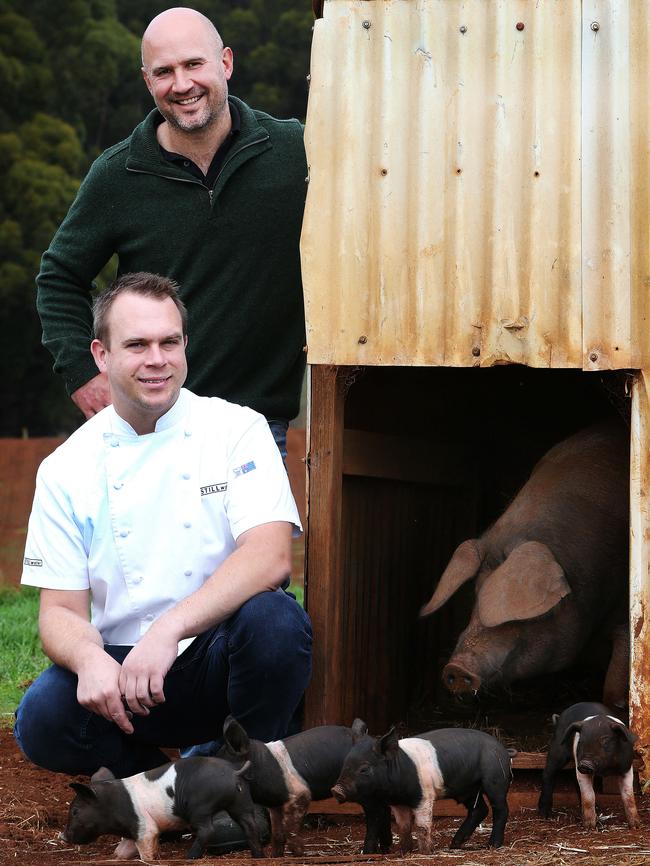
Lelong is surprised and chuffed she has found a market for the oca leaves, having expected to sell only the roots, and also for the seemingly-past-their-best beans. “They’ll work well as a dried bean for purees or soups,” Todd says. “I should come here more often.”
Lelong has always had a vegetable patch to feed her family and satisfy her passion for gardening, selling excess fruit to neighbours. But she has upped the ante since forming the relationship with Ethos.
“Because of the way Iain works, it means people like me have a market,” she says. “Instead of supplying to a restaurant that needs so many kilos each week, I’ll call Iain up and tell him what I have, he’ll tell me what he wants and I’ll bring it down.”
Lelong makes her deliveries on foot, using her trusty shopping cart to ferry it downhill to the city. Todd says Lelong was the first of about a dozen backyard growers in Hobart who regularly supply to Ethos.
“We were very flattered when Liz approached us,” he says. “It’s nice having someone put so much effort into their produce and wanting to give it to us. We are really happy to support these growers. That’s the point of the daily changing menu at Ethos. We can use a couple of kilos of something, we don’t need a three-month supply.”
SWEET SUCCESS
“All in one go. You have to commit,” Jeff Workman instructs, as I contemplate whether I can politely put the entire snack he has just prepared in my mouth, or if a dainty half-bite is more advisable.
Workman is head chef at Federal Group’s new baby Peacock and Jones, an intimate restaurant in the Henry Jones complex on Hobart’s waterfront. The snack is a buttery sable biscuit made with Pyengana cheddar, topped with a delectable-looking piece of Tasmanian honeycomb, oozing with deep golden goodness. I inhale the floral aroma of the honey – so incredibly different to supermarket versions – and munch on the crumbly, chewy concoction, nodding in agreement to Workman’s summation: “It’s salty and sweet, kind of like salted caramel in a way.” This scrumptious morsel would not have been created had Antonia and Robin O’Brien not spent a sleepless night saving their beehives in Tasmania’s South West from a bushfire in January.
“We were out there from 7pm to 5am,” Antonia says. “Ten hours moving the hives to safer ground. There was ash falling on us, the bees were not happy. It’s not something you want to do often.”
The couple, who own Wellington Apiary, put their 75 precious beehives on a trailer and moved them 35km up the road, to the other side of the fire, where they knew they would be safe. Other beekeepers were not so lucky as bushfires ripped through Tasmania’s wilderness. The O’Briens predict a major shortage of local honey as producers grapple with burnt hives, destroyed leatherwood forests and, to top it off, decreased production due to drought conditions.
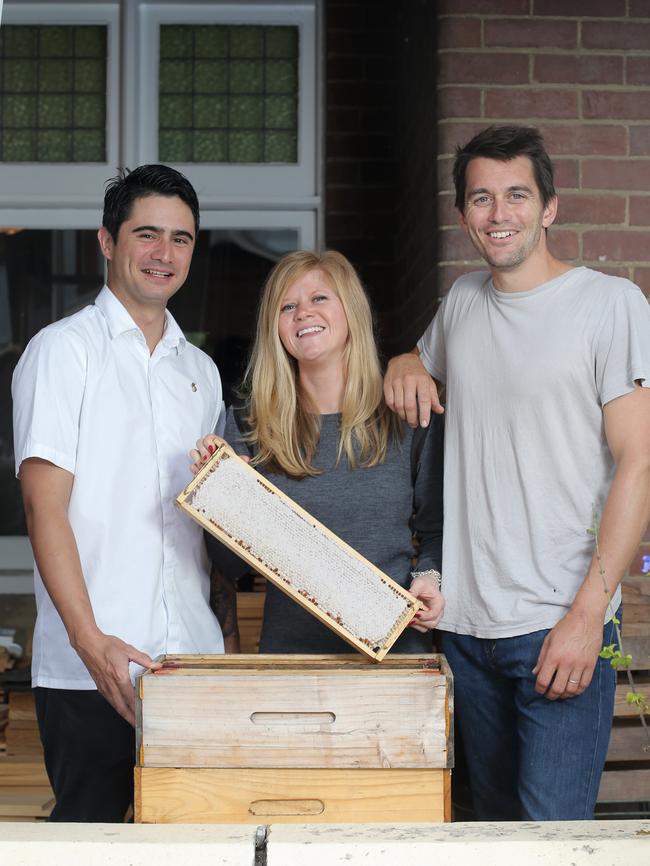
Although the couple did not lose any hives, their production is affected by the dry weather and loss of leatherwood. Their entire honeycomb production has been pre-sold, most of it snapped up by Neil Perry’s Rockpool group interstate. Workman is the only local chef to have secured a supply of the Wellington honeycomb, which is thanks to the relationship he has formed with the O’Briens since he spotted their product on Sprout Tasmania’s Fork to Fork website – an ingenious online farmers market, delivering produce from small growers to households and businesses.
“I love honey so I immediately took notice when the honeycomb popped up on the Fork to Fork website. I hadn’t seen honeycomb supplied like that before,” says Workman, who was seconded to run the Peacock and Jones kitchen after three years in the kitchen at Federal’s acclaimed Saffire resort.
In summer, most of the restaurant’s customers were tourists, but Workman says word has got out among locals. The menu is proudly local, which Workman hopes will make diners more aware and appreciative of the diversity of produce available in the state.
“It’s good for locals to see what’s being produced here,” Workman says. “And it’s being produced by people who are passionate about what they do. When I arrived at Antonia and Robin’s house the other day, Antonia was in the middle of a phone call talking about beehives and there’s hives and equipment all around their house. It’s not just a job, it’s a lifestyle for them, as cooking is for me.”
For the O’Briens, the relationship with Workman gives them an opportunity to showcase their honey – in dishes such as honey and prune cake and burnt honey ice-cream – as well as a market for low-volume products.
“We’ve got a couple of small-batch varieties of honey like fennel that are not big enough to run under our own label,” Antonia says. “It’s hard for beekeepers to market small amounts so it’s great to be able to supply to people like Jeff who know how to work with honey.”
WHERE THERE’S A WILL
Launceston chef Craig Will and North-West farmer Guy Robertson share an understanding that goes well beyond a typical customer-supplier relationship. They are kindred spirits in a way, both heavily involved in Tasmania’s eat-local movement and firmly of the belief that happier animals make for tastier meat.
It is hard to imagine happier pigs than those that potter about the lush green pastures of Robertson’s picturesque Mt Gnomon Farm. These rare-breed porkers are a permanent feature on Will’s menu at Launceston’s Stillwater, in the form of chorizo, ham, occasionally offal and one of his signature dishes, pork belly. Through trial and error,
Will and his kitchen team believe they have nailed the secret to the perfect pork belly. And, generously, he is happy to share it.
The belly is placed in a house-made brine, exactly 4.5 per cent salinity, for 12 hours, then cooked sous-vide for another 12 hours at exactly 83C. “If you do it at 82C, the fat doesn’t break down in the same way,” Will says. Once a diner orders the dish the pork is finished off skin-down in a smoking-hot pan in the oven for eight minutes.
“You get a perfectly cooked piece of pork that’s crispy-skinned with meat that’s juicy and succulent,” he says.
So there you have it. However, the real secret, Will says, is the type of pork you use. “No other pork quite tastes like Guy’s pork,” Will says. “With mass-produced pork, it has that piggy, metallic taste. Guy’s has perfect fat-to-meat ratio and you can see that in the end product.”
Robertson says his farm business would not be nearly as viable without the reliability of his verbal contract with Will. “It’s more like a partnership than a customer-client relationship,” he says. “It’s important that you’re reliable for them and they’re reliable for you.”
Will says his customers are not complaining. “I’ve been using it for six years and we take eight [whole] bellies a week, so that’s a lot of serves and there have been no complaints,” he says. “It would be easy to go out and buy cheaper pork and make more money on the dish but sometimes it’s not about that. It’s about believing in something. We want to see more of what Guy is doing in the future and the only way to do that is to support them from the ground up.”
The men met when Will worked under Paul Foreman at Hobart’s former Marque IV restaurant and Robertson was just starting out, on a minute scale, as a free-range pig farmer. “Paul was getting a bit of his produce and when I moved to Launceston that was the first thing I wanted to get in, but Guy was only just getting off the ground,” Will says. His commitment to buy a certain amount of product each week helped Robertson expand production.
He now has a restaurant and hosts events on site, while also manning stalls at weekly farmers’ markets and occasional music festivals – he sold 1500 serves in three hours at last month’s Missy Higgins concert at Skyfields near Sheffield. Robertson believes Tasmanians’ love of farmers’ markets and the increased willingness of restaurants to seek out local suppliers means small-scale farming has never been more rewarding.
“I think it’s a really good time to be a primary producer,” Robertson says. “There is a lot more opportunity now than 10 years ago. We’ve got farmers’ markets all across Tasmania.”
FRIENDSHIP FORGED FROM FOOD
Also kindred spirits, with a relationship built as much on friendship as commerce, are vegetable grower Tony Scherer and Franklin head chef Jessica Muir. The pair met because their respective partners used to work together, but Scherer and Muir have bonded over a love of the rather European way of life that can be enjoyed in Tassie. On Muir’s days off, she and Scherer might get together to make cheese, drink wine and dream about all they want to grow at Scherer’s organic vegetable farm in the Coal River Valley.
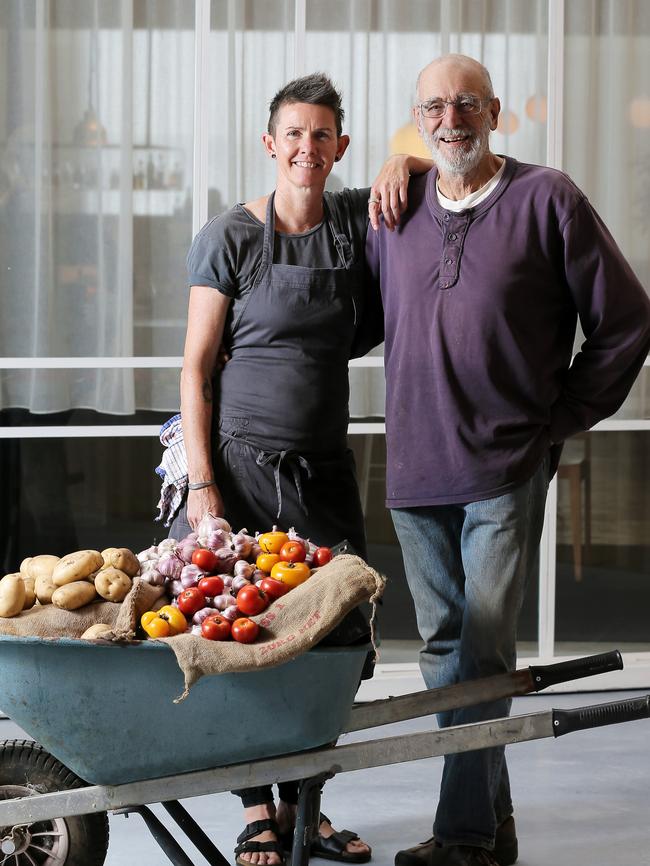
“Jess will come over to our place and make wood-fired pizzas,” Scherer says as he and Muir appreciatively pick up and smell the huge, perfectly ripe tomatoes he has just delivered to Franklin.
Muir, who was previously head chef for Christine Manfield’s restaurants in Sydney, moved to Tasmania two years ago to man the kitchen at Franklin alongside co-owner and fellow chef David Moyle. When Manfield explained her reasons for closing her famous restaurant Universal in 2013, she described Muir as her “right-hand woman” and said it was Muir who explained to staff why it was a wonderful thing to close while the restaurant was still at its peak, going out “on a high”. Muir had worked with Manfield from the early ’90s, when Manfield’s first Sydney restaurant Paramount opened.
Muir says her cooking style has changed dramatically since moving to Tasmania. No longer is she making the complex and rich Asian-style sauces she did in Sydney. “It has definitely changed, particularly in the past two years,” Muir says of her cooking. “It is less complicated. In Sydney I had to use more disguises than I do now. The difference is the produce. I’ve never used produce so good, ever.”
Things that would never have stood alone at Universal, such as broccoli and cauliflower, shine as star ingredients at Franklin. Muir
says she spent a year before the opening of Franklin getting to know the produce available in Tasmania at different times of year, how to source the best and how to optimally showcase their flavour.
“You can’t just come down here and open a restaurant. You need to understand how things work and build those relationships with your producers,” she says. “One of the many things that surprised me was that in Tasmania the winter vegetables almost outdo the summer. Last winter we had the most amazing produce, we were taking photos left, right and centre. We had the most amazing cabbages, which we wood-roasted. That’s all they needed.”
Early each week, Scherer and a handful of other small-scale farmers, including Richard and Belinda Weston, deliver their goods to Franklin. The bounty is laid out on tables and the menu is devised. “The menu is never written before we see the produce,” Muir says. “If you want to use local produce there’s no other way.”
While Muir is full of praise for Scherer’s ability to achieve optimum flavour in his produce, not least his organic purple garlic, she wishes she could either clone him or encourage others to follow his lead.
“More small farmers would be fantastic but these people are rare. For something on this scale it has to be a passion,” she says. “You need to love and enjoy what you do because it’s not the smartest business idea. Neither are restaurants.”
“No, it’s not,” Scherer agrees, although he says you can “earn a living” by focusing on high-quality premium produce, instead of trying to emulate big supermarket suppliers.
“At 73, I question my sanity,” he says. “It’s hard work but I can’t stop. It’s so satisfying to go some place like Franklin and see something you’ve grown and what they’ve done to it … it is incredibly rewarding.”
For more great lifestyle reads, grab a copy of TasWeekend in the Saturday Mercury.

